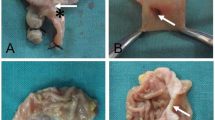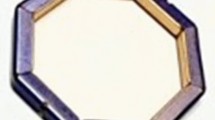Abstract
Purpose
The magnetic compression technique (MCT) is a new surgical method that has been used for gastrointestinal anastomosis, choledochojejunostomy, and intestinal anastomosis, but there are no reports on its use for esophagogastric anastomosis. This study aimed to investigate the feasibility of using MCT to fashion esophagogastric anastomoses in rabbits.
Methods
Twenty rabbits were randomized into an MCT group (study group, n = 10) and a hand-sewn group (control group, n = 10). The magnetic compression anastomosis device used in this study was made of neodymium iron boron (NdFeB) and possessed parent (PMR) and daughter (DMR) magnetic rings. To fashion the anastomosis, the PMR and DMR were inserted into the lower esophagus and gastric fundus, respectively. The coupled magnets automatically compressed the sandwiched tissues and were expelled once the anastomosis was installed. The two groups were further compared in terms of the anastomosis construction time, survival rate, and postoperative complications. One month after the anastomosis was installed, the burst pressure and gross appearance of the anastomoses were evaluated.
Results
The anastomosis construction time in the study group was significantly shorter than that in the control group (10.50 ± 1.58 min vs. 18.60 ± 2.22 min; P < 0.05), and the magnetic rings were defecated out in 10.70 ± 3.49 days. The incidence of anastomotic blockage in both the study and control groups did not differ significantly (0%, 0/10 vs. 20%, 2/10; P > 0.05). Anastomotic leakage was not found in either of the groups, and the anastomoses burst pressures were similar in the two groups. However, the magnetically compressed anastomoses in the study group had a relatively smoother gross appearance than the hand-sewn anastomoses.
Conclusion
The magnetic compression anastomosis device is a safe and feasible tool for fashioning esophagogastric anastomoses in this animal model.






Similar content being viewed by others
References
Wang ZQ, Jiang YQ, Xu W, Cai HR, Zhang Z, Yin Z, Zhang Q. A novel technique for cervical gastro-oesophageal anastomosis during minimally invasive oesophagectomy. Int J Surg 2018; 53: 221-229.
Hanyu T, Kosugi S, Ishikawa T, Ichikawa H, Wakai T. Incidence and risk factors for anastomotic stricture after esophagectomy with gastric tube reconstruction. Hepatogastroenterology 2015; 62: 892-897.
Messager M, Warlaumont M, Renaud F, Marin H, Branche J, Piessen G, Mariette C. Recent improvements in the management of esophageal anastomotic leak after surgery for cancer. Eur J Surg Oncol 2017; 43: 258-269.
Qiu B, Feng F, Gao S. Partial esophagogastrostomy with esophagogastric anastomosis below the aortic arch in cardiac carcinoma: characteristics and treatment of postoperative anastomotic leakage. J Thorac Dis 2015; 7: 1994-2002.
Honda M, Kuriyama A, Noma H, Nunobe S, Furukawa TA. Hand-sewn versus mechanical esophagogastric anastomosis after esophagectomy: a systematic review and meta-analysis. Ann Surg 2013; 257: 238-248.
Wang Q, He XR, Shi CH, Tian JH, Jiang L, He SL, Yang KH. Hand-sewn versus stapled esophagogastric anastomosis in the neck: a systematic review and meta-analysis of randomized controlled trials. Indian J Surg 2015; 77: 133-140.
Castro PM, Ribeiro FP, Rocha Ade F, Mazzurana M, Alvarez GA. Hand-sewn versus stapler esophagogastric anastomosis after esophageal ressection: systematic review and meta-analysis. Arq Bras Cir Dig 2014; 27: 216-221.
Luechakiettisak P, Kasetsunthorn S. Comparison of hand-sewn and stapled in esophagogastric anastomosis after esophageal cancer resection: a prospective randomized study. J Med Assoc Thai 2008; 91: 681-685.
Graves CE, Co C, Hsi RS, Kwiat D, Imamura-Ching J, Harrison MR, Stoller ML. Magnetic compression anastomosis (magnamosis): first-in-human trial. J Am Coll Surg 2017; 225: 676-681.
Yan XP, Shang P, Shi AH, Liu WY, Liu YX, Lv Y. Exploration and establishment of magnetic surgery (in Chinese). Chin Sci Bull 2019; 64: 815-826.
Jamshidi R, Stephenson JT, Clay JG, Pichakron KO, Harrison MR. Magnamosis: magnetic compression anastomosis with comparison to suture and staple techniques. J Pediatr Surg 2009; 44:222-228.
Ma F, Ma J, Ma SJ, Fu S, Zhang Y, Liu H, Lv Y, Wu RQ, Yan XP. A novel magnetic compression technique for small intestinal end-to-side anastomosis in rats. J Pediatr Surg 2019; 54: 744-749.
An YF, Zhang Y, Liu H, Ma SJ, Fu S, Lv Y, Yan XP. Gastrojejunal anastomosis in rats using the magnetic compression technique. Sci Rep 2018; 8: 11620.
Bai JG, Huo XW, Ma J, Lv Y, Yan XP. Magnetic compression technique for colonic anastomosis in rats. J Surg Res 2018; 231: 24-29.
Liu XM, Yan XP, Zhang HK, Ma F, Guo YG, Fan C, Wang SP, Shi AH, Wang B, Wang HH, Li JH, Zhang XG, Wu R, Zhang XF, Lv Y. Magnetic anastomosis for biliojejunostomy: first prospective clinical trial. World J Surg 2018; 42: 4039-4045.
Wang HH, Ma J, Wang SP, Ma F, Lu JW, Xu XH, Lv Y, Yan XP. Magnetic anastomosis rings to create portacaval shunt in a canine model of portal hypertension. J Gastrointest Surg 2019; 23: 2184-2192.
Yan XP, Liu WY, Ma J, Li JP, Lv Y. Extrahepatic portacaval shunt via a magnetic compression technique: a cadaveric feasibility study. World J Gastroenterol 2015; 21: 8073-8080.
Gao Y, Wu RQ, Lv Y, Yan XP. Novel magnetic compression technique for establishment of a canine model of tracheoesophageal fistula. World J Gastroenterol 2019; 25: 4213-4221.
Yan XP, Zou YL, She ZF, Ma F, Zhang J, Liu WY, Lv Y. Magnet compression technique: a novel method for rectovaginal fistula repair. Int J Colorectal Dis 2016; 31:937-938.
Funding
This study was supported by the Innovation Capability Support Plan of Shaanxi Province, No. 2020KJXX-022; the Key Research & Development Program-Social Development of Shaanxi Province, No. 2021SF-163. The funders had no role in the study design, data collection and analysis, decision to publish, or preparation of the manuscript.
Author information
Authors and Affiliations
Contributions
Conception and design: Yi Lyu, Xiao-Peng Yan.
Performed the research and acquired the data: Wen-Wen Chen, Hui-Min Gao, Xiao-Peng Yan, Dan Ye, Ai-Hua Shi, Wei-Chen Shen, Miao-Miao Zhang, Jia-Hui Zhang.
Analyzed the data: Dan Ye, Miao-Miao Zhang, Ai-Hua Shi.
Manuscript writing: Xiao-Peng Yan, Dan Ye, Miao-Miao Zhang.
Manuscript revision: Yi Lyu, Xiao-Peng Yan.
Final approval of manuscript: all authors.
Corresponding author
Ethics declarations
Ethics Approval
The Committee on the Ethics of Animal Experiments of Xi’an Jiaotong University (Permit Number: XJTULAC2019-999) approved the study protocol.
Conflict of Interest
The authors declare no competing interests.
Additional information
Publisher's Note
Springer Nature remains neutral with regard to jurisdictional claims in published maps and institutional affiliations.
Rights and permissions
About this article
Cite this article
Ye, D., Zhang, MM., Shi, AH. et al. Construction of Esophagogastric Anastomosis in Rabbits with Magnetic Compression Technique. J Gastrointest Surg 25, 3033–3039 (2021). https://doi.org/10.1007/s11605-021-05178-9
Received:
Accepted:
Published:
Issue Date:
DOI: https://doi.org/10.1007/s11605-021-05178-9




